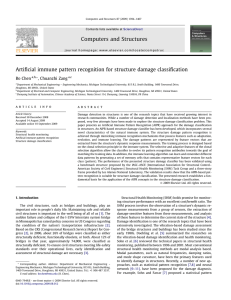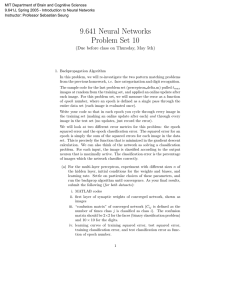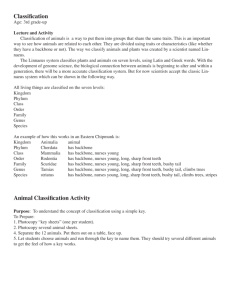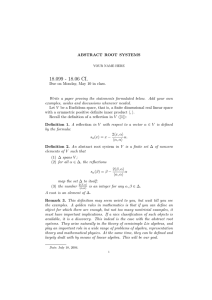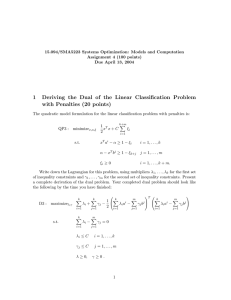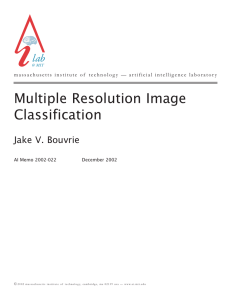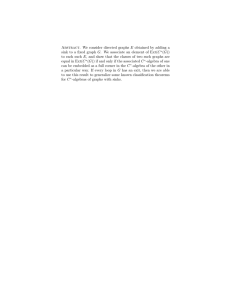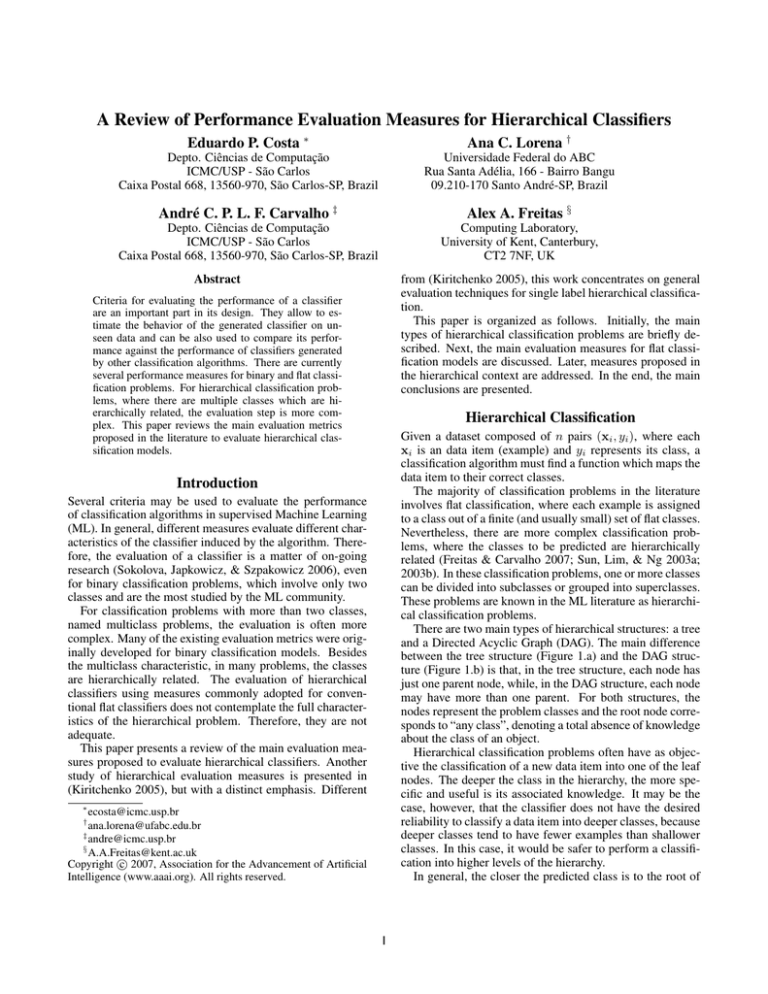
A Review of Performance Evaluation Measures for Hierarchical Classifiers
Eduardo P. Costa ∗
Ana C. Lorena †
Depto. Ciências de Computação
ICMC/USP - São Carlos
Caixa Postal 668, 13560-970, São Carlos-SP, Brazil
Universidade Federal do ABC
Rua Santa Adélia, 166 - Bairro Bangu
09.210-170 Santo André-SP, Brazil
André C. P. L. F. Carvalho ‡
Alex A. Freitas §
Depto. Ciências de Computação
ICMC/USP - São Carlos
Caixa Postal 668, 13560-970, São Carlos-SP, Brazil
Computing Laboratory,
University of Kent, Canterbury,
CT2 7NF, UK
from (Kiritchenko 2005), this work concentrates on general
evaluation techniques for single label hierarchical classification.
This paper is organized as follows. Initially, the main
types of hierarchical classification problems are briefly described. Next, the main evaluation measures for flat classification models are discussed. Later, measures proposed in
the hierarchical context are addressed. In the end, the main
conclusions are presented.
Abstract
Criteria for evaluating the performance of a classifier
are an important part in its design. They allow to estimate the behavior of the generated classifier on unseen data and can be also used to compare its performance against the performance of classifiers generated
by other classification algorithms. There are currently
several performance measures for binary and flat classification problems. For hierarchical classification problems, where there are multiple classes which are hierarchically related, the evaluation step is more complex. This paper reviews the main evaluation metrics
proposed in the literature to evaluate hierarchical classification models.
Hierarchical Classification
Given a dataset composed of n pairs (xi , yi ), where each
xi is an data item (example) and yi represents its class, a
classification algorithm must find a function which maps the
data item to their correct classes.
The majority of classification problems in the literature
involves flat classification, where each example is assigned
to a class out of a finite (and usually small) set of flat classes.
Nevertheless, there are more complex classification problems, where the classes to be predicted are hierarchically
related (Freitas & Carvalho 2007; Sun, Lim, & Ng 2003a;
2003b). In these classification problems, one or more classes
can be divided into subclasses or grouped into superclasses.
These problems are known in the ML literature as hierarchical classification problems.
There are two main types of hierarchical structures: a tree
and a Directed Acyclic Graph (DAG). The main difference
between the tree structure (Figure 1.a) and the DAG structure (Figure 1.b) is that, in the tree structure, each node has
just one parent node, while, in the DAG structure, each node
may have more than one parent. For both structures, the
nodes represent the problem classes and the root node corresponds to “any class”, denoting a total absence of knowledge
about the class of an object.
Hierarchical classification problems often have as objective the classification of a new data item into one of the leaf
nodes. The deeper the class in the hierarchy, the more specific and useful is its associated knowledge. It may be the
case, however, that the classifier does not have the desired
reliability to classify a data item into deeper classes, because
deeper classes tend to have fewer examples than shallower
classes. In this case, it would be safer to perform a classification into higher levels of the hierarchy.
In general, the closer the predicted class is to the root of
Introduction
Several criteria may be used to evaluate the performance
of classification algorithms in supervised Machine Learning
(ML). In general, different measures evaluate different characteristics of the classifier induced by the algorithm. Therefore, the evaluation of a classifier is a matter of on-going
research (Sokolova, Japkowicz, & Szpakowicz 2006), even
for binary classification problems, which involve only two
classes and are the most studied by the ML community.
For classification problems with more than two classes,
named multiclass problems, the evaluation is often more
complex. Many of the existing evaluation metrics were originally developed for binary classification models. Besides
the multiclass characteristic, in many problems, the classes
are hierarchically related. The evaluation of hierarchical
classifiers using measures commonly adopted for conventional flat classifiers does not contemplate the full characteristics of the hierarchical problem. Therefore, they are not
adequate.
This paper presents a review of the main evaluation measures proposed to evaluate hierarchical classifiers. Another
study of hierarchical evaluation measures is presented in
(Kiritchenko 2005), but with a distinct emphasis. Different
∗
ecosta@icmc.usp.br
ana.lorena@ufabc.edu.br
‡
andre@icmc.usp.br
§
A.A.Freitas@kent.ac.uk
c 2007, Association for the Advancement of Artificial
Copyright Intelligence (www.aaai.org). All rights reserved.
†
1
is built by a flat classification algorithm. Its disadvantage is
that errors made in higher levels of the hierarchy are propagated to the most specific levels.
In the big-bang approach, a classification model is created
in a single run of the algorithm, considering the hierarchy of
classes as a whole. Therefore, it increases the algorithmic
complexity, but it can potentially avoid the previously mentioned disadvantage of the top-down approach. After the
classifier training, the prediction of the class of a new data
item is carried out in just one step.
Flat Performance Measures
Generally, the evaluation measures in classification problems are defined from a matrix with the numbers of examples correctly and incorrectly classified for each class,
named confusion matrix. The confusion matrix for a binary
classification problem (which has only two classes - positive
and negative), is shown in Table 1.
Figure 1: Examples of hierarchies of classes: (a) structured
as a tree and (b) structured as a DAG.
the tree, the lower the classification error tends to be. On the
other hand, such classification becomes less specific and, as
a consequence, less useful. Therefore, a hierarchical classifier must deal with the trade-off class specificity versus classification error rate.
In some problems, all examples must be associated to
classes in leaf nodes. These problems are named “mandatory leaf-node prediction problems”. When this obligation
does not hold, the classification problem is an “optional leafnode prediction problem”.
Following the nomenclature in (Freitas & Carvalho 2007),
four approaches to deal with hierarchical problems with ML
techniques may be cited: transformation of the hierarchical
problem into a flat classification problem, hierarchical prediction with flat classification algorithms, top-down classification and big-bang classification.
The first approach reduces the original hierarchical problem to a single flat classification problem, which often considers only the leaf node classes from the hierarchy. This
idea is supported by the fact that a flat classification problem may be viewed as a particular case of hierarchical classification, in which there are no subclasses and superclasses.
Traditional approaches for flat classification may be applied
in this context.
The second approach divides a hierarchical problem into a
set of flat classification problems, usually one for each level
of the hierarchy. Each class level is treated as an independent
classification problem. Flat classification algorithms may
then be used for each level.
In the top-down approach, one or more classifiers are
trained for each level of the hierarchy. This produces a tree
of classifiers. The root classifier is trained with all training
examples. At the next class level, each classifier is trained
with just a subset of the examples. E.g, in the class tree
of Fig. 1(a), a classifier associated with the class node 1
would be trained only with data belonging to class 1.1 or
1.2, ignoring instances from classes 2.1 or 2.2. This process
proceeds until classifiers predicting the leaf class nodes are
produced. In the test phase, beginning at the root node, an
example is classified in a top-down manner, according to the
predictions produced by a classifier in each level. Although
this approach produces a tree of classifiers, each classifier
Table 1: Confusion Matrix
Predicted Class
True Class Positive Negative
Positive
TP
FN
Negative
FP
TN
The FP, FN, TP and TN concepts may be described as:
• False positives (FP): examples predicted as positive,
which are from the negative class.
• False negatives (FN): examples predicted as negative,
whose true class is positive.
• True positives (TP): examples correctly predicted as pertaining to the positive class.
• True negatives (TN): examples correctly predicted as belonging to the negative class.
The evaluation measure most used in practice is the
accuracy rate (Acc). It evaluates the effectiveness of the
classifier by its percentage of correct predictions. Equation
1 shows how Acc is computed, where |A| denotes the
cardinality of set A.
|T N | + |T P |
(1)
|F N | + |F P | + |T N | + |T P |
The complement of Acc is the error rate (Err) (Equation
2), which evaluates a classifier by its percentage of incorrect predictions. Acc and Err are general measures and
can be directly adapted to multiclass classification problems.
Acc =
|F N | + |F P |
= 1 − Acc (2)
|F N | + |F P | + |T N | + |T P |
The recall (R) and specificity (Spe) measures evaluate
the effectiveness of a classifier for each class in the binary
problem. The recall, also known as sensitivity or true
positive rate, is the proportion of examples belonging to the
positive class which were correctly predicted as positive.
Err =
2
the true class of an example, Cp the predicted class and M
is the number of classes in the problem.
The specificity is the percentage of negative examples
correctly predicted as negative. R and Spe are given by
equations 3 and 4, respectively.
|T P |
R=
|T P | + |F N |
Distance-based Measures
(3)
Classes that are close to each other in a hierarchy tend to be
more similar to each other than other classes. Therefore, this
approach considers the distance between the true class and
the predicted class in the class hierarchy in order to compute the hierarchical classification performance. It was proposed in (Wang, Zhou, & Liew 1999) and used in (Sun &
Lim 2001) in the context of hierarchical text classification.
More precisely, Sun & Lim extended the conventional (flat
classification-based) measures of precision, recall, accuracy
and error rate for the context of distance-based hierarchical
classification error. However, a drawback of this approach is
that it does not consider the fact that classification at deeper
class levels tends to be significantly more difficult than classification at shallower levels.
Sun & Lim first calculate the false positive contribution
for each class Ci (F pConi ) (Equation 7, using terms defined
in equations 8 and 9). To calculate this contribution, an acceptable distance, denoted as Disθ , is defined. It should be
specified by the user and should be larger than zero. These
equations were adapted from (Sun & Lim 2001), where they
were originally designed to evaluate multilabel hierarchical problems. A classification problem is named multilabel
when a data may be associated to more than one class simultaneously. In the case of multilabel hierarchical classification problems, more than one path may be followed in the
hierarchy for the classification of a new example.
|T N |
(4)
|F P | + |T N |
Precision (P) is a measure which estimates the probability
that a positive prediction is correct. It is given by Equation
5 and may be combined with the recall originating the
F-measure. A constant β controls the trade-off between
the precision and the recall, as can be seen in Equation 6.
Generally, it is set to 1.
Spe =
P =
|T P |
|T P | + |F P |
(5)
(β 2 + 1) ∗ P ∗ R
(6)
β2 ∗ P + R
Other common evaluation measure used in binary classification problems is the ROC (Receiver Operating Characteristics), which relates sensitivity and specificity. Although
ROC curves were originally developed for two-class problems, they have also been generalized for multi-class problems (Everson & Fieldsend 2006). The reader should refer
to (Bradley 1997) for a detailed description of ROC analysis.
All previous measures are inadequate for hierarchical
classification models. By not taking into account the hierarchical structure of the problem, they ignore the fact that
the classification difficulty tends to increase for deeper levels of the class hierarchy.
Consider, for example, the hierarchy presented in Fig.
1(a). Suppose that two examples, both from class 2.1, were
incorrectly predicted. One was associated with class 2.2 and
the other as belonging to class 1.1. In a uniform misclassification cost measure, as those previously presented, both
misclassifications would be equally penalized. Therefore,
the measure would not consider that, based on the hierarchy, classes 2.1 and 2.2 are more similar to each other than
classes 2.1 and 1.1.
In order to avoid these deficiencies, new evaluation measures have been proposed, specific for hierarchical classification models. They are discussed in the next section.
F − measure =
F pConi =
RCon(x, Cp )
(7)
xF Pi
Con(x, Cp ) = 1.0 −
Dis(Cp , Ct )
Disθ
RCon(x, Cp ) = min(1, max(−1, Con(x, Cp )))
(8)
(9)
For each class, first the contribution of each false positive
(Con) is calculated (Equation 8). In this equation, x denotes
a data item and Dis(Cp , Ct ) denotes the distance between
Cp and Ct . Next, a Refined-Contribution (RCon) is calculated (Equation 9), which normalizes the contribution of
each example in the [−1, 1] interval. Once the RCon value
has been obtained for each false positive, a summation is
performed and the F pConi value for class Ci is obtained,
using Equation 7.
Besides F pConi , a false negative contribution (F nConi )
is calculated for each class Ci . Its calculation is similar to
that of F pConi , as can be seen in Equation 10. In the calculation of RCon (Equation 9) and Con (Equation 8), Cp and
Ct are replaced by Ct and Cp , respectively.
Hierachical Performance Measures
There are several alternatives to measure the predictive performance of a hierarchical classification algorithm. They
can be generally grouped into four types: distance-based,
depth-dependent, semantics-based and hierarchy-based. It
should be noticed that some measures may use concepts
from more than one approach. They were classified according to their most prominent characteristic.
In order to facilitate the understanding of how the evaluation of a hierarchical classifier may be performed, this section has the equations for the main evaluation measures described. The following notation was adopted: Ct represents
F nConi =
RCon(x, Ct )
(10)
xF Ni
Based on the F pConi and F nConi values, some extended measures may be defined: precision, recall, accuracy
3
rate and error rate, which are presented in equations 11, 12,
13 and 14, respectively.
P =
max(0, |T Pi | + F pConi + F nConi )
|T Pi | + |F Pi | + F nConi
(11)
R=
max(0, |T Pi | + F pConi + F nConi )
|T Pi | + |F Ni | + F pConi
(12)
Acc =
|T N | + |T P | + F pConi + F nConi
|F N | + |F P | + |T N | + |T P |
(13)
Err =
|F P | + |F N | − F pConi − F nConi
|F N | + |F P | + |T N | + |T P |
(14)
Another problem pointed by (Lord et al. 2003) also considers the case where the hierarchy depth varies significantly
for different leaf nodes. According to Lord et al., when two
classes C1 and C2 are located in different subtrees of the
root class - i.e., when the deepest common ancestor of both
C1 and C2 is the root class - the fact that one of these classes
is deeper than the other does not necessarily mean that the
former is more informative to the user than the latter. For
instance, a class at the third level of the tree can be associated with information as specific as a class at the eighth level
of the tree, if the two classes are in different subtrees of the
root class. Therefore, the assignment of weights considering
only the depth of an edge - and not the information associated with the classes at the two end points of the edge - can
be a problem.
There is another drawback in the distance-based and
depth-dependent distance-based measures. Although the
distance between the predicted and the true class is easily
defined in the case of a tree-based class hierarchy, the definition of this distance in the case of a DAG-based class hierarchy is more difficult and involves more computational
time. In particular, in a DAG, the concept of the “depth” of
a class node is not trivial, since there can be multiple paths
from the root node to a given class node.
Depth-dependent Measures
The approach proposed by (Blockeel et al. 2002) tries to
avoid the distanced-based measures’ drawback by making
classification error costs at shallower class levels higher than
classification error costs at deeper class levels. In this extended measure, the distance between two classes is defined
as a function of two factors, namely: (a) the number of
edges between the predicted class and the true class in the
graph representing the class hierarchy (where each node of
the graph represents a class); and (b) the depth of the true
and predicted classes in the class hierarchy. For the sake
of simplicity, consider the case of a tree-based class hierarchy. One way of defining this function involves assigning a
weight (cost) to each edge in the tree representing the class
hierarchy. Hence, the classification error associating the difference between a predicted class and the true class is given
by the summation of the weights of all the edges in the path
between these two classes. In order to implement the principle that classification error costs at shallower class levels
should be higher than classification error costs at deeper levels, the weights of edges at deeper levels tend to be smaller
than the weights of edges at shallower levels.
Observe that this approach introduces the problem of how
to set the weight for each edge. The solution used in (Holden
& Freitas 2006) and (Blockeel et al. 2002) decreases the
value of weights exponentially with the depth of the edge.
Both works used these weights in the calculation of the accuracy rate. However, this solution presents its own problems.
One of them occurs when the tree is very unbalanced in the
sense that the tree depth (i.e., the distance between the root
node and a leaf node) varies significantly for different leaf
nodes. When this is the case, a misclassification involving a
pair of predicted and true leaf classes at a level closer to the
root will be less penalized than a misclassification involving a pair of predicted and true leaf classes at a level further
from the root, simply because the latter will be associated
with more edges in the path between the predicted and the
true classes. It can be argued that this smaller penalization
is not fair, because the classification involving the shallower
level cannot reach a deeper level due to the limited depth of
the former.
Semantics-based Measures
This approach, also proposed by (Sun & Lim 2001), uses the
concept of class similarity to calculate the prediction performance of the classification model. The inspiration to use
similarity between classes to estimate the classification error
rate is the intuitive notion that it is less severe to misclassify
a new example into a class close to the true class than into a
class with no relation to the true class.
This similarity may be calculated in different ways. In
(Sun & Lim 2001), each class is described by a feature
vector. For example, Ci is described by the feature vector
{w1 , w2 , ..., wH }, where H is the number of features. The
similarity between classes is calculated using these vectors.
This similarity is later used to define the precision, recall,
accuracy and error rates.
For each pair of classes Ci and Cj , the Category Similarity (CS) is calculated (Equation 15). The similarities
between the categories can be used to define the Average
Category Similarity (ACS), given by Equation 16. For each
category, the CS and ACS values are used to calculate the
contribution (Con) of the false positives and false negatives. For the false positive case, the calculation of Con
is given by Equation 17. For the false negative case, the
same equation is used replacing Cp and Ct by Ct and Cp , respectively. Once Con is calculated, the procedure to obtain
the performance evaluation measures is the same followed
for the distance-based measures, also proposed by (Sun &
Lim 2001) and described in the subsection “Distanced-based
Measures”. Again, some adaptations were performed in
the equations, which were originally proposed to multilabel
classification problems.
4
predicted class (Equation 20). It is important to notice that
the set Ancestor(C) includes the class C itself. Besides,
the root node is not considered an ancestor from class C,
because, by default, all examples belong to the root node.
|Ancestor(Cp ) ∩ Ancestor(Ct )|
hP =
(20)
|Ancestor(Cp )|
To calculate the recall, the number of common ancestors
is divided by the number of ancestors of the true class, as can
be observed in Equation 21. As in the previous approach,
these measures were used to calculate an extension of the
F-measure, named hierarchical F-measure. Independently, a
similar measure was proposed by (Eisner et al. 2005). It is
an extension of the approach from (Poulin 2004) to calculate
the precision and recall values for multilabel problems.
|Ancestor(Cp ) ∩ Ancestor(Ct )|
(21)
hR =
|Ancestor(Ct )|
H
wk × vk
CS(Ci , Cj ) = k=1
(15)
H
H
2 ×
2
w
v
k=1 k
k=1 k
M M
2 × i=1 j=i+1 CS(Ci , Cj )
(16)
ACS =
M × (M − 1)
CS(Cp , Ct ) − ACS
Con(x, Cp ) =
(17)
1 − ACS
A problem with the semantics-based measures is that several hierarchies, particular those related to biology, already
take some form of semantic relationships into consideration
when they are built (Freitas & Carvalho 2007). In these situations, the classes closer in the hierarchy are also semantically more similar. Thus, the distance should also be considered in the prediction evaluation. The distance-independent
semantic measures between pairs of classes could also be
used to construct a new hierarchy and the error rates could
then be evaluated using the distance between classes in this
new hierarchy.
Other Evaluation Measures
Other measures were also investigated, as those defined in
(Cesa-Bianchi, Gentile, & Zaniboni 2006), (Cai & Hofmann
2004), (Wu et al. 2005), (Wang, Zhou, & He 2001), (Lord et
al. 2003) and (Verspoor et al. 2006). These other measures
are not directly related with the previous categories.
The measures from (Cesa-Bianchi, Gentile, & Zaniboni
2006) and (Cai & Hofmann 2004) can be regarded as
application-specific. Wu et al. and Wang, Zhou & He
propose measures for the multilabel case, which lose their
evalution power when applied to non-multilabel problems,
which are the focus of this paper. Besides, the measure proposed by (Wang, Zhou, & He 2001) is only used in the construction of the hierarchical classifier, and not in its evaluation. In (Verspoor et al. 2006), an extension of the measure defined in (Kiritchenko, Matwin, & Famili 2004) is
proposed, adapting it to the multilabel context. Lord et al.
proposed a similarity measure that combines the semantic
information associated with a class with the structure of the
class hierarchy. Nevertheless, this similarity was not used in
the evaluation of a classification model. A possible extension of this measure allows the use of this similarity index
in the evaluation of a hierarchical classification model, as
performed in (Sun & Lim 2001).
Another approach that can be used to estimate the hierarchical classification error rates involves the use of a misclassification cost matrix. This approach, proposed in (Freitas & Carvalho 2007), is a generalization of the misclassification cost matrix for standard flat classification (Witten &
Frank 2000). This matrix stores the pre-defined cost of each
possible misclassification. One drawback of this approach
is the definition of these costs, which may be a subjective
task. Besides, for a classification problem with a large number of classes, a frequent scenario in hierarchical classification problems, the dimension of the cost matrix becomes too
high, which makes it even more difficult the calculation of
the costs.
Hierarchy-based Measures
This approach uses concepts of ancestral and descendant
classes to formulate new evaluation measures. One example of such approach is presented in (Ipeirotis, Gravano, &
Sahami 2001). Ipeirotis et al. use the concept of descendant
classes in their performance evaluation by considering the
subtrees rooted in the predicted class and in the true class.
Each subtree is formed by the class itself and its descendants. The intersection of these subtrees is then used to calculate extended precision and recall measures. To calculate
the precision, the number of classes belonging to the intersection is divided by the number of classes belonging to the
subtree rooted at the predicted class, as can be seen in Equation 18. In this equation, Descendant(C) represents the
set of classes contained in the subtree whose root is C. It
corresponds to the descendants of C, including C itself.
hP =
|Descendant(Cp ) ∩ Descendant(Ct )|
|Descendant(Cp )|
(18)
To calculate the recall, the number of classes belonging
to the intersection is divided by the number of classes in the
subtree rooted at the true class, as illustrated in Equation 19.
Once the hierarchical prediction and recall measures have
been calculated, they are used to calculate a hierarchical extension of the F-measure. The problem with this measure is
its assumption that the predicted class is either a subclass or
a superclass of the true class. When these classes are in the
same level, for example, their intersection is an empty set.
hR =
|Descendant(Cp ) ∩ Descendant(Ct )|
|Descendant(Ct )|
(19)
In a similar measure, Kiritchenko, Matwin & Famili (Kiritchenko, Matwin, & Famili 2004) uses the notion of ancestors in order to calculate the classification errors. For this,
the authors consider the number of common ancestors in the
true class and the predicted class. To calculate the precision, this value is divided by the number of ancestors of the
Conclusions
This survey reviewed some of the main evaluation measures
for hierarchical classification models.
5
Algorithm. In Proceedings of the 2006 IEEE Swarm Intelligence Symposium (SIS-2006), 77–84.
Ipeirotis, P.; Gravano, L.; and Sahami, M. 2001. Probe,
count, and classify: categorizing hidden web databases. In
Proceedings of the 2001 ACM SIGMOD international conference on Management of data, 67–78. ACM Press New
York, NY, USA.
Kiritchenko, S.; Matwin, S.; and Famili, A. 2004. Hierarchical Text Categorization as a Tool of Associating Genes
with Gene Ontology Codes. In Proceedings of the 2nd
European Workshop on Data Mining and Text Mining for
Bioinformatics, 26–30.
Kiritchenko, S. 2005. Hierarchical Text Categorization
and Its Application to Bioinformatics. Ph.D. Dissertation,
School of Information Technology and Engineering, Faculty of Engineering, University of Ottawa, Ottawa, Canada.
Lord, P.; Stevens, R.; Brass, A.; and Goble, C. 2003. Investigating semantic similarity measures across the Gene
Ontology: the relationship between sequence and annotation. Bioinformatics 19(10):1275–1283.
Poulin, B. 2004. Sequenced-based protein function prediction. Master’s thesis, Department of Computing Science,
University of Alberta, Edmonton, Alberta, Canada.
Sokolova, M.; Japkowicz, N.; and Szpakowicz, S. 2006.
Beyond accuracy, f-score and roc: a family of discriminant
measures for performance evaluation. In Proceedings of
the AAAI’06 workshop on Evaluation Methods for Machine
Learning, 24–29.
Sun, A., and Lim, E. P. 2001. Hierarchical text classification and evaluation. In Proceedings of the 2001 IEEE
International Conference on Data Mining, 521–528. IEEE
Computer Society Washington, DC, USA.
Sun, A.; Lim, E. P.; and Ng, W. K. 2003a. Hierarchical text
classification methods and their specification. Cooperative
Internet Computing 256:18 p.
Sun, A.; Lim, E. P.; and Ng, W. K. 2003b. Performance measurement framework for hierarchical text classification. Journal of the American Society for Information
Science and Technology 54(11):1014–1028.
Verspoor, K.; Cohn, J.; Mniszewski, S.; and Joslyn, C.
2006. A categorization approach to automated ontological
function annotation. Protein Science 15(6):1544–1549.
Wang, K.; Zhou, S.; and He, Y. 2001. Hierarchical classification of real life documents. In Proceedings of the 1st
(SIAM) International Conference on Data Mining, 1–16.
Wang, K.; Zhou, S.; and Liew, S. 1999. Building hierarchical classifiers using class proximity. In Proceedings of the
25th International Conference on Very Large Data Bases,
363–374.
Witten, I. H., and Frank, E. 2000. Data Mining - practical machine learning tools and techniques with Java implementations. Morgan Kauffmann Publishers.
Wu, H.; Su, Z.; Mao, F.; Olman, V.; and Xu, Y. 2005.
Prediction of functional modules based on comparative
genome analysis and Gene Ontology application. Nucleic
Acids Research 33(9):2822–2837.
It can be observed from the study conducted that there is
not yet a consensus concerning which evaluation measure
should be used in the evaluation of a hierarchical classifier.
Several measures have been proposed, but none of them was
adopted frequently by the ML community. As future work,
it would be interesting to empirically compare the hierarchical classification evaluation measures. Until now, reported
works usually compare one given hierarchical measure to a
flat counterpart. However, a direct comparison of the relative
effectiveness of different measures of hierarchical classification is far from trivial, because there is no clear definition of
a criterion for choosing “the best measure”, out of different measures. However, there is a strong need for empirical comparisons of different hierarchical classification measures, to better identify their similarities and differences e.g., to what extent they are correlated with each other.
Additionally, as several hierarchical classification problems are also multilabel, it is important to investigate the use
of hierarchical evaluation measures in classification problems which are hierarchical and multilabel.
Acknowledgement
The authors would like to thank the financial support from
the Brazilian research agencies FAPESP and CNPq.
References
Blockeel, H.; Bruynooghe, M.; Dzeroski, S.; Ramon, J.;
and Struyf, J. 2002. Hierarchical multi-classification.
In Proceedings of the ACM SIGKDD 2002 Workshop on
Multi-Relational Data Mining (MRDM 2002), 21–35.
Bradley, A. P. 1997. The use of the area under the roc curve
in the evaluation of machine learning algorithms. Pattern
Recognition 30:1145–1159.
Cai, L., and Hofmann, T. 2004. Hierarchical document
categorization with support vector machines. In Proceedings of the Thirteenth ACM conference on Information and
knowledge management, 78–87.
Cesa-Bianchi, N.; Gentile, C.; and Zaniboni, L. 2006. Hierarchical classification: combining Bayes with SVM. In
Proceedings of the 23rd international conference on Machine learning, 177–184. ACM Press New York, NY, USA.
Eisner, R.; Poulin, B.; Szafron, D.; Lu, P.; and Greiner,
R. 2005. Improving Protein Function Prediction using the
Hierarchical Structure of the Gene Ontology. In Proceedings of the 2005 IEEE Symposium on Computational Intelligence in Bioinformatics and Computational Biology CIBCB’05, 1–10.
Everson, R. M., and Fieldsend, J. E. 2006. Multi-class roc
analysis from a multi-objective optimisation perspective.
Pattern Recogn. Lett. 27(8):918–927.
Freitas, A. A., and Carvalho, A. C. P. F. 2007. A Tutorial
on Hierarchical Classification with Applications in Bioinformatics. In: D. Taniar (Ed.) Research and Trends in Data
Mining Technologies and Applications. Idea Group. 176–
209.
Holden, N., and Freitas, A. A. 2006. Hierarchical Classification of G-Protein-Coupled Receptors with PSO/ACO
6

